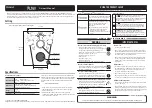
Section 10. Troubleshooting
411
10.4 Communications
10.4.1 RS-232
Baud rate mis-match between the CR800 and datalogger support software is often
the root of communication problems through the RS-232 port. By default, the
CR800 attempts to adjust its baud rate to that of the software. However, settings
changed in the CR800 to accommodate a specific RS-232 device, such as a smart
sensor, display or modem, may confine the RS-232 port to a single baud rate. If
the baud rate can be guessed at and entered into support software parameters,
communications may be established. Once communications is established, CR800
baud rate settings can be changed. Clues as to what the baud rate may be set at can
be found by analyzing current and previous CR800 programs for the
SerialOpen()
instruction;
SerialOpen()
specifies a baud rate. Documentation
provided by the manufacturer of the previous RS-232 device may also hint at the
baud rate.
10.4.2 Communicating with Multiple PCs
The CR800 can communicate with multiple PCs simultaneously. For example,
the CR800 may be a node of an internet PakBus network communicating with a
distant instance of
LoggerNet
. An onsite technician can communicate with the
CR800 using
PC200W
via a serial connection, so long as the PakBus addresses of
the host PCs are different. All Campbell Scientific datalogger support software
include utilities for altering PC PakBus addressing.
10.4.3 Comms Memory Errors
CommsMemFree()
is an array of three registers in the
Status
table
(p. 506)
that
report communications memory errors. In summary, if any
CommsMemFree()
register is at or near zero, assistance may be required from Campbell Scientific to
diagnose and correct a potentially serious communications problem. Sections
CommsMemFree(1)
(p. 411),
CommsMemFree(2)
(p. 413),
and
CommsMemFree(3)
(p.
413)
explain the possible communications memory errors in detail.
10.4.3.1 CommsMemFree(1)
CommsMemFree(1):
Number of buffers used in all communication, except with
the external keyboard / display. Two digits per each buffer size category. Most
significant digits specify the number of larger buffers. Least significant digits
specify the number of smaller buffers. When
TLS
(p. 446)
is not active, there are
four-buffer categories:
tiny
,
little
,
medium
, and
large
. When TLS is active, there
is a fifth category,
huge
, and more buffers are allocated for each category.
When a buffer of a certain size is required, the smallest, suitably-sized pool that
still has at least one buffer free will allocate a buffer and decrement the number in
reserve. When the communication is complete, the buffer is returned to the pool
and the number for that size of buffer will increment.
When TLS is active, the number of buffers allocated for
tiny
can only be
displayed as the number of tiny buffers modulo divided by 100.
Содержание CR850
Страница 2: ......
Страница 4: ......
Страница 6: ......
Страница 26: ...Table of Contents 26...
Страница 30: ...Section 2 Cautionary Statements 30...
Страница 32: ...Section 3 Initial Inspection 32...
Страница 35: ...Section 4 Quickstart Tutorial 35 Figure 2 Wiring panel...
Страница 55: ...Section 4 Quickstart Tutorial 55 Figure 24 PC200W View data utility...
Страница 78: ...Section 5 System Overview 78...
Страница 80: ...Section 6 CR800 Specifications 80...
Страница 95: ...Section 7 Installation 95 Figure 35 DevConfig OS download window Figure 36 Dialog box confirming OS download...
Страница 104: ...Section 7 Installation 104 Figure 43 Include File settings via DevConfig Figure 44 Include File settings via PakBusGraph...
Страница 267: ...Section 7 Installation 267 Figure 84 Running average signal attenuation...
Страница 268: ...Section 7 Installation 268...
Страница 384: ...Section 8 Operation 384 Figure 113 Using the keyboard display...
Страница 385: ...Section 8 Operation 385 8 8 1 Data Display Figure 114 Displaying data with the keyboard display...
Страница 387: ...Section 8 Operation 387 Figure 116 Real time custom...
Страница 388: ...Section 8 Operation 388 8 8 1 3 Final Storage Tables Figure 117 Final storage tables...
Страница 389: ...Section 8 Operation 389 8 8 2 Run Stop Program Figure 118 Run Stop Program...
Страница 390: ...Section 8 Operation 390 8 8 3 File Display Figure 119 File display...
Страница 396: ...Section 8 Operation 396...
Страница 402: ...Section 9 Maintenance 402...
Страница 450: ...Section 11 Glossary 450...
Страница 504: ...Appendix A CRBasic Programming Instructions 504...
Страница 526: ...Appendix B Status Table and Settings 526...
Страница 530: ...Appendix C Serial Port Pinouts 530...
Страница 536: ...Appendix E FP2 Data Format 536...
Страница 550: ...Appendix F Other Campbell Scientific Products 550...
Страница 564: ...Index 564 WriteIO 464 Writing Program 108 X XML 448 XOR 473 Y Y intercept 141 142 Z Zero 155 166 Zero Basis 151...
Страница 565: ......
















































